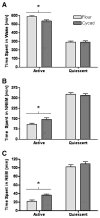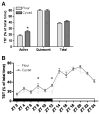Sleep alterations in an environmental neurotoxin-induced model of parkinsonism
- PMID: 20713046
- PMCID: PMC2955757
- DOI: 10.1016/j.expneurol.2010.08.005
Sleep alterations in an environmental neurotoxin-induced model of parkinsonism
Abstract
Parkinson's disease (PD) is classically defined as a motor disorder resulting from decreased dopamine production in the basal ganglia circuit. In an attempt to better diagnose and treat PD before the onset of severe motor dysfunction, recent attention has focused on the early, non-motor symptoms, which include but are not limited to sleep disorders such as excessive daytime sleepiness (EDS) and REM behavioral disorder (RBD). However, few animal models have been able to replicate both the motor and non-motor symptoms of PD. Here, we present a progressive rat model of parkinsonism that displays disturbances in sleep/wake patterns. Epidemiological studies elucidated a link between the Guamanian variant of Amyotrophic Lateral Sclerosis/Parkinsonism Dementia Complex (ALS/PDC) and the consumption of flour made from the washed seeds of the plant Cycas micronesica (cycad). Our study examined the effects of prolonged cycad consumption on sleep/wake activity in male, Sprague-Dawley rats. Cycad-fed rats exhibited an increase in length and/or number of bouts of rapid eye movement (REM) sleep and Non-REM (NREM) sleep at the expense of wakefulness during the active period when compared to control rats. This hypersomnolent behavior suggests an inability to maintain arousal. In addition, cycad-fed rats had significantly fewer orexin cells in the hypothalamus. Our results reveal a novel rodent model of parkinsonism that includes an EDS-like syndrome that may be associated with a dysregulation of orexin neurons. Further characterization of this early, non-motor symptom, may provide potential therapeutic interventions in the treatment of PD.
Copyright © 2010 Elsevier Inc. All rights reserved.
Figures




References
-
- Abbott RD, Ross GW, White LR, et al. Excessive daytime sleepiness and subsequent development of Parkinson disease. Neurology. 2005;65:1442–1446. - PubMed
-
- Arnulf I, Konofal E, Merino-Andreu M, et al. Parkinson’s disease and sleepiness: an integral part of PD. Neurology. 2002;58:1019–1024. - PubMed
-
- Barraud Q, Lambrecq V, Forni C, et al. Sleep disorders in Parkinson’s disease: the contribution of the MPTP non-human primate model. Exp Neurol. 2009;219 (2):574–582. - PubMed
-
- Baumann CR, Bassetti CL. Hypocretins (orexins) and sleep–wake disorders. Lancet Neurol. 2005;4:673–682. Review. - PubMed
-
- Carlsson A, Lindqvist M, Magnusson T. 3, 4-Dihydroxyphenylalanine and 5-hydroxytryptophan as reserpine antagonists. Nature. 1957;180:1200. - PubMed
Publication types
MeSH terms
Substances
Grants and funding
LinkOut - more resources
Full Text Sources
Miscellaneous

